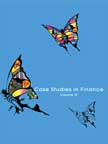A Comparison of Risk and Return Between BSE Sensex and Bank Fixed Deposits
|
|
ICMR HOME | Case Studies Collection
Case Details:
Case Code : FINC059
Case Length : 17 Pages
Period : 1994-2008
Pub. Date : 2009
Teaching Note :Not Available
Organization : Bombay Stock Exchange
Industry : Financial Services
Countries : India
To download A Comparison of Risk and Return Between BSE Sensex and Bank Fixed Deposits case study (Case Code:
FINC059) click on the button below, and select the case from the list of available cases:


Price:
For delivery in electronic format: Rs. 300;
For delivery through courier (within India): Rs. 300 + Rs. 25 for Shipping &
Handling Charges
» Finance Case
Studies
» Short Case Studies
» View Detailed Pricing Info
» How To Order This Case
» Business Case Studies
» Area Specific Case Studies
» Industry Wise Case Studies
» Company Wise Case Studies
Please note:
This case study was compiled from published sources, and is intended to be used as a basis for class discussion. It is not intended to illustrate either effective or ineffective handling of a management situation. Nor is it a primary information source.
Chat with us

Please leave your feedback

|
|




<< Previous
Returns from Stock Markets
|
Let us have a look at the returns generated by the Indian stock market (BSE) over the last fifteen years between March 31, 1992 and March 31, 2007. The Sensex increased from 4285 points on March 31, 1992 to 13072.10 points as on March 31, 2007 (Refer Exhibit II for the BSE Sensex Chart). The compounded annual growth rate (CAGR) recorded by the BSE Sensex during this period is 7.72 percent (Refer Table I for the annual return and standard deviation recorded by BSE Sensex between March 1992 and March 2007).
To calculate the return generated by Sensex and its standard deviation, we have taken the closing figures of Sensex on March 31 each year. In case March 31 is a holiday, we have taken the preceding day's figures.
|

|
From these figures, we have first calculated the year-on-year
return on the index by using the following formula:
Return generated by Sensex = ((I1 - I0)/ I0) × 100
Here I0 = Closing figure of previous year
I1 = Closing figure of just concluded year or present year
For calculating the average return, we have added all the annual returns obtained between 1992 and 2007 and divided the figure by the number of years. In other words, for the period we are looking at i.e. 15 years, the figure obtained is the average return on Sensex over 15-year period. Similarly, we have calculated returns for ten years, seven years, five years, three years, two years and one-year period (Refer Exhibit III to Exhibit VIII)...
Excerpts >>

|
|










